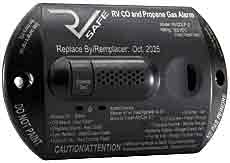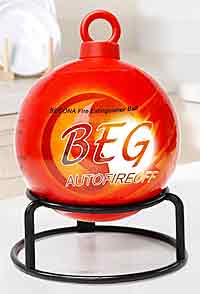Fire Safety for Tiny Homes and RV’s
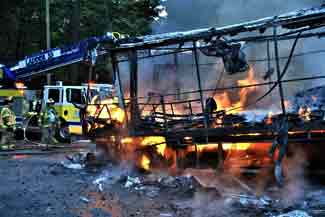
Fire safety in a tiny home or RV is critically important. If you’re home, you will be very close to the fire. A tiny home/RV can be engulfed in flames in just seconds. NOW is the time to plan. Will you have any warning? Could you get out fast enough? What if you are asleep in the loft? Do you have an escape plan and equipment right at hand to extinguish the blaze?
See the importance of fire safety in this YouTube® video. Just six minutes to total destruction.
Picture at the top of page is a screen shot from this video.
Fire Detection
The best-case scenario in case of a fire is early detection. Your tiny abode may or may not have required smoke detectors to pass an inspection or obtain insurance, but there is no circumstance where they are not needed, and there is no excuse for not having them. While not a fire concern, a carbon monoxide detector is also a critical factor is keeping you and/or your family safe. Lastly, if you use propane, a propane detector can save your life.
Halloween: it’s not just for goblins anymore
For years I only changed the batteries in these devices when they started to run low. This meant an ear-piercing, obnoxious chirping that inevitably began at 3:00am. Eventually I would stagger out of bed, get a ladder from the backyard (which was sometimes in deep snow), rip the detector loose from the ceiling, remove the battery, and go back to sleep. Maybe. I cannot tell you how much this irritated me.
Finally, in 2022, I gave into my wife’s plea to do what fire departments everywhere urge us to do: change all the batteries every Halloween. Since that day, we have not been rudely awakened by the incessant beeping of a battery gone bad. Yes, I will do it again in 2023. It’s worth it.
Fire Suppression
A fire extinguisher should be standard equipment for any home. The National Park Service and the National Fire Prevention Association recommend you have three fire extinguishers: One in the bedroom, one in the kitchen, and one in an unlocked outside storage area or the tow vehicle. Fire extinguishers are basic.
But there are a few more important steps you can take to ensure your safety.
Fire Suppression Canisters
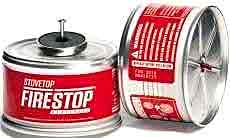
These magnetic fire suppression canisters attach to your range hood. They automatically burst open and extinguish a stove top fire in seconds.
StoveTop FireStop Plus, the next evolution in automatic fire suppression, features improved styling, an enhanced powder delivery mechanism and an increased functional range of use to accommodate today’s modern kitchens. Just attach the pre-installed magnet to the top of your ventilation hood or cabinetry and if a cooking fire occurs, STFS Plus puts it out automatically.
These canisters can also be used in storage areas where you might be storing flammables like gas or paint.
Click on picture to order from Amazon.
Fireball Automatic Fire Extinguisher
This fire ball extinguisher automatically explodes within 3-5 seconds after being exposed to 320 degrees Fahrenheit. It can also automatically explode when thrown into the fire, allowing it to be used immediately when wanted. Let it work while you are making your escape, or throw into flames to create a path to safety.
Keep one in the kitchen, living area, and bedroom for peace of mind. It makes a very loud noise when activated so if it goes off in the kitchen area it will wake you up if you are asleep in the bedroom.
I’ve also seen them hung on Christmas trees, in the solar battery shed, and engine compartments of RV’s.
Tiny Wood Stove Fire Safety
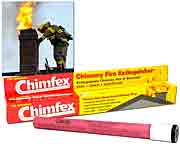
In addition to the fire extinguisher methods on this page, those with wood stoves will need some additional fire safety products.
Stopping a chimney fire
Chimney fires are dangerous, so make sure you’re prepared in the event you have one. The original Chimfex is America’s leading chimney fire extinguisher*. Protect your home and your family by using Chimfex, the product that’s used by homeowners, professional firefighters and chimney sweeps nationwide! Chimfex can extinguish a chimney fire in just seconds.
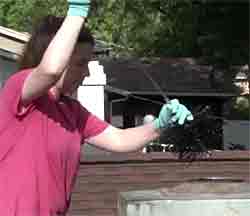
Clean creosote from the inside of the chimney
A chimney sweep/vent brush on a flexible rod is connected to a drill and used to clean the creosote buildup out of the chimney.
Fire Extinguishers for RV’s and Tiny Homes

A fire extinguisher seems like a no-brainier but there are different extinguishers for different things that are burning. One of the newest threats is lithium batteries.
Fighting a Lithium Battery Fire
Lithium battery fires are very difficult to extinguish. It take a particular type of foam to smother the blaze. Most fire trucks are not equipped with this new extinguisher yet.
The Burn Buster fire extinguisher shown here is effective for putting out Class A (wood, paper, cloth) and Class C (live electrical equipment) fires, the eco-conscious formulation of our lithium battery fire extinguisher gel is safe for people, pets, and electronics.
Fire Blanket
Having an emergency fire blanket nearby is also a good idea. Instantly smother grease, liquid, and small flammable fires with this fiberglass fire blanket. Leaves zero residue unlike traditional fire extinguishers. Perfect fire safety solution for home, kitchen, camping and vehicles.
See more fire extinguisher types in the products section of this page.
Building codes are for your safety.
When designing your tiny home, adhere to Appendix-Q building codes, especially for loft access and landing. These building codes are designed with your safety in mind. A firefighter needs to be able to rescue you from the loft area if you are incapacitated. They need to be able to maneuver with all of their gear on and carry you to safety.
Design extra exits into your home
A skylight that opens in your loft ceiling adds a great deal of safety to your home by providing an additional exit. If your roof does not have a safe way to get down, make sure you have an emergency escape ladder nearby. Every two-story home should have these.
Fire Safe Building Materials
Here is a good video showing the burn properties of different kinds of insulation. Note that the popular spray-in foam does not readily burn, but does emit a deadly black toxic smoke when exposed to fire.
Unexpected fire hazards
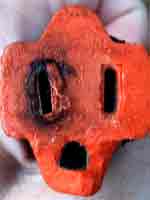
Damp charcoal can spontaneously ignite. Buy a fresh bag and store in a metal container.
Using an insufficient (too light) extension cord can cause the wires to become hot enough to melt and ignite.
Corroded connectors create high resistance then heat. I’ve seen many an RV shore power extension cord melted because of this. Visit this page, Melted RV Shore Power Plug How to Avoid Tragedy, to see how to clean your extension cord connectors.
More pages of the Tiny Life Consulting website you’ll be interested in
All About Shore Power, Surge Protectors, 50 amp, 30 amp Hookups



